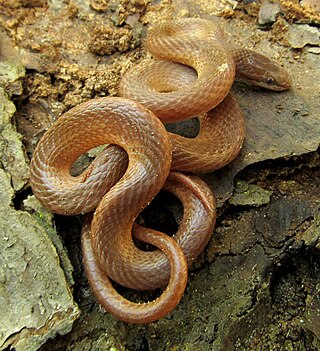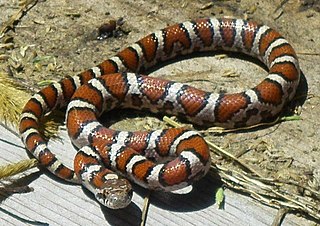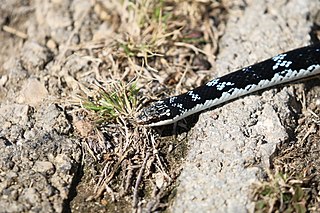
Liophis is a former genus of New World colubrid snakes. [1] They have a wide range of nondescript and local names, among these "water snakes", "mapepires", "corals" or "racers".

Liophis is a former genus of New World colubrid snakes. [1] They have a wide range of nondescript and local names, among these "water snakes", "mapepires", "corals" or "racers".
The status of the genus Liophis on the mainland of South America is highly uncertain, and some authorities assign some species to the genera Dromicus, Erythrolamprus, Leimadophis, Lygophis , and Philodryas . Others consider Dromicus and Leimadophis to be synonyms of Liophis. [2]

Colubridae is a family of snakes. With 249 genera, it is the largest snake family. The earliest species of the family date back to the Oligocene epoch. Colubrid snakes are found on every continent except Antarctica.

The royal ground snake is a species of snake in the family Colubridae. The species is endemic to northern South America.

Hypsiglena jani, commonly known as the Texas night snake or the Chihuahuan night snake, is a small species of mildly venomous snake in the family Colubridae. The species is native to the southwestern United States and adjacent northeastern Mexico.

Xenodontinae is a subfamily of snakes in the family Colubridae.

Erythrolamprus is a genus of colubrid snakes, commonly known as false coral snakes, native to Central America, the Caribbean, and the northern part of South America. They appear to be coral snake mimics.
The Barbados racer, also commonly known as the tan ground snake, was a species of colubrid snake that was endemic to Barbados. It is now extinct.

The pine woods snake, also commonly known as the yellow-lipped snake or the brown-headed snake, is a species of secretive colubrid found in scattered locations across the south-eastern United States. Rhadinaea flavilata is rear-fanged and mildly-venomous, but not dangerous to humans.

Tachymenis is a genus of venomous snakes belonging to the family Colubridae. Species in the genus Tachymenis are commonly known as slender snakes or short-tailed snakes and are primarily found in southern South America. Tachymenis are rear-fanged (opisthoglyphous) and are capable of producing a medically significant bite, with at least one species, T. peruviana, responsible for human fatalities.

Julia's ground snake is a species of snake in the family Colubridae. The species is found in the Caribbean, on the Lesser Antilles islands of Dominica and Guadeloupe.
Shaw's dark ground snake, also known commonly as Shaw's black-backed snake, and in Spanish as candelilla, guarda caminos, and reinita cazadora, is a species of snake in the family Colubridae. The species is native to northern South America.
In the 10th edition of Systema Naturae, Carl Linnaeus described the Amphibia as:
Animals that are distinguished by a body cold and generally naked; stern and expressive countenance; harsh voice; mostly lurid color; filthy odor; a few are furnished with a horrid poison; all have cartilaginous bones, slow circulation, exquisite sight and hearing, large pulmonary vessels, lobate liver, oblong thick stomach, and cystic, hepatic, and pancreatic ducts: they are deficient in diaphragm, do not transpire (sweat), can live a long time without food, are tenatious of life, and have the power of reproducing parts which have been destroyed or lost; some undergo a metamorphosis; some cast (shed) their skin; some appear to live promiscuously on land or in the water, and some are torpid during the winter.
Caryospora is a genus of parasitic protozoa in the phylum Apicomplexa. The species in this genus infect birds and reptiles with the majority of described species infecting snakes. It is the third largest genus in the family Eimeriidae.

Lampropeltis triangulum triangulum, commonly known as the eastern milk snake or eastern milksnake, is a subspecies of the milk snake. The nonvenomous, colubrid snake is indigenous to eastern and central North America.

Mastigodryas is a genus of colubrid snakes. Like some other colubrids, they are commonly called racers. It is a Neotropical genus, with members distributed from Mexico to Argentina and several islands in the Caribbean. Some authorities use the older generic name, Dryadophis, for these species.

The Galápagos racer is a colubrid snake in the genus Pseudalsophis that is endemic to the Galápagos Islands. It is a mildly venomous constrictor but it is not considered aggressive or harmful to humans. The two subspecies are the eastern and western racers, the latter being larger, longer, and darker than the former. The western subspecies specializes in hunting fish, while both subspecies eat small reptiles, eggs, rodents, and bird hatchlings. The Galapagos racer is near threatened due to recently introduced species that feed on snake eggs, including pigs, rats, mice, and cats. It is one of only three species of snakes on the Galápagos Islands, and it was first described in 1860. In November 2016, a video clip from the BBC series Planet Earth II showing a group of Galápagos racers hunting marine iguana hatchlings became a viral trend.

Caraiba is a monotypic genus of snakes in the family Colubridae. The genus contains the sole species Caraiba andreae, also known commonly as the black and white racer or the Cuban lesser racer, which is endemic to Cuba. There are six recognized subspecies.

Baliodryas is a genus of snakes in the family Colubridae. It is monotypic, being represented by the single species, Baliodryas steinbachi. It is endemic to South America.
Erythrolamprus fraseri is a species of snake in the family Colubridae. The species is native to northwestern South America.
Incaspis simonsii is a species of snake in the family Colubridae..